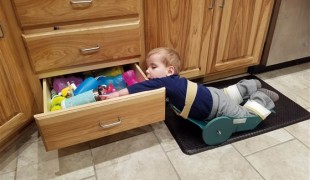- 9561
- 658
- 9
- 13
- 0
- Help Ukraine
About the solution
Shortly after the birth, Rose had problems in breathing and spent a week in Intensive Care Unit. Her mother Sinead thought that the cribs in which her daughter was sleeping weren’t safe enough.
“We loved how portable our moses basket was as we needed to keep Rose very close. But to me it didn’t feel strong, the handles in particular didn’t feel great, it was impossible to clean and the hood would not stay up”, the mother explained.
But what triggered everything was the period in which Rose was at the hospital.
“Community midwives thought it was newborn baby ‘snuffles’, but we went to the hospital and she was admitted. I sat up all night with a nurse helping her to breathe with a steam box”, Sinead recalled.
When Rose was able to go home, she had a tube called a central line in her chest, which helped her breathe.
Rose slept in a regular crib basket. According to her mother, the rustling of the wicker kept both her daughter and the parents awake at night.
“Something bigger than you kicks in. I realised I needed something to keep Rose safe”.
So she decided to create a larger, stronger, quieter and easy-to-clean basket so that as Rose grew she wouldn’t be limited on where she could sleep just by her size. This crib is wicker-less, the handles are stronger than most and hypoallergenic, with a hood that stays put.
After creating this special crib, and prototyping, the innovator founded, with her husband Adam, their own company – Shnuggle – in 2012. They produce and sell clever baby products.
Shnuggle won Best In Home Product Award from the Baby Products Association in 2013 and Best Cot Design at the Junior awards in 2014, can be used by all mothers who are looking for easier solutions to bed and bath time.
More info: http://huff.to/2hZ52hy
Adapted from: https://www.shnuggle.com
This solution shall not include mention to the use of drugs, chemicals or biologicals (including food); invasive devices; offensive, commercial or inherently dangerous content. This solution was not medically validated. Proceed with caution! If you have any doubts, please consult with a health professional.
DISCLAIMER: This story was written by someone who is not the author of the solution, therefore please be advised that, although it was written with the utmost respect for the innovation and the innovator, there can be some incorrect statements. If you find any errors please contact the patient Innovation team via info@patient-innovation.com
-
-
329
-
0
-
3414

Student invents device to help with arm mobility
BODY BALANCE: Maintaining body balance
CAREGIVING
Bone Disorders (Decalcification, Bone Deformity, Bone Fracture, Bone Infection)
Gastrointestinal Bleeding
Assistive Daily Life Device (to help ADL)
Limited range of motion
Reduced grip force (grip)
Loss of muscle coordination
Joint deformity
Swelling or inflammation
Blood in the stool (hematochezia)
Restoring mobility
Maintaining Balance and Mobility
Preventing (Vaccination, Protection, Falls, Research/Mapping)
Caregiving Support
Cardiology
Clinical Hematology
Infectious Diseases
Medical Genetics
Orthopedics
Pediatrics
United States
-
-
-
966
-
0
-
20989

System to track autistic children
CAREGIVING
COMMUNICATION: Communicating, whether by speaking, listening, or other means
Social interaction
Autism
Assistive Daily Life Device (to help ADL)
Body-Worn solutions (Clothing, accessories, shoes, sensors...)
App (Including when connected with wearable)
Anxiety
Difficulty concentrating or making decisions
Social withdrawal or isolation
Restlessness or feeling slowed down
Loss of interest or pleasure in activities (anhedonia)
Promoting self-management
Managing Neurological Disorders
Preventing (Vaccination, Protection, Falls, Research/Mapping)
Caregiving Support
Child and Adolescent Psychiatry
Medical Genetics
Neurology
Pediatrics
Psychiatry
Israel
-
-
-
662
-
0
-
9976

Dad creates device to help 2-year-old son with spina bifida
CAREGIVING
BODY BALANCE: Maintaining body balance
Spinal Cord and Nerve Root Disorders
Assistive Daily Life Device (to help ADL)
Strategy/Tip
Gait abnormalities (e.g., walking difficulties, unsteady gait)
Difficulty coordinating movements
Stiffness or rigidity (difficulty moving)
Paralysis of the legs and lower body
Muscle weakness
Loss of balance
Cognitive impairment
Restoring mobility
Maintaining Balance and Mobility
Preventing (Vaccination, Protection, Falls, Research/Mapping)
Caregiving Support
Medical Genetics
Neurology
Neurosurgery
Pediatrics
United States
-
 en
en